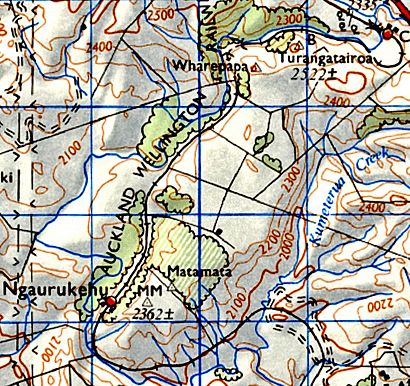Ngaurukehu railway station facts for kids
Quick facts for kids
Ngaurukehu railway station
|
|||||||||||
|---|---|---|---|---|---|---|---|---|---|---|---|

Ngaurukehu railway station on 1970 map
|
|||||||||||
| Location | New Zealand | ||||||||||
| Coordinates | 39°36′41″S 175°42′30″E / 39.611300°S 175.708200°E | ||||||||||
| Elevation | 640 m (2,100 ft) | ||||||||||
| Line(s) | North Island Main Trunk | ||||||||||
| Distance | Wellington 270.79 km (168.26 mi) | ||||||||||
| History | |||||||||||
| Opened | 1 July 1909 | ||||||||||
| Closed | 1992 | ||||||||||
| Electrified | June 1988 | ||||||||||
| Services | |||||||||||
|
|||||||||||
Ngaurukehu, Ngarukehu, or Ngaurakehu, was a flag station on the North Island Main Trunk line, in the Ruapehu District of New Zealand. It is in the Hautapu River valley. It was 9.64 km (5.99 mi) north of Mataroa, 3.91 km (2.43 mi) south of Turangarere. Ngaurukehu is part way up a 1 in 70 gradient from Mataroa to Hīhītahi, so that it is 110 m (360 ft) above Mataroa and 62 m (203 ft) below Turangarere. It now has three passing loops.
History
The line through Ngaurukehu was built and equipped with a telegraph line by the Public Works Department (PWD) in 1906. It was transferred to NZR on 1 July 1908, but sidings north and south of the single track weren't opened until Thursday 1 July 1909. They were added to reduce delays caused by trains waiting to clear each other on the climb from Mataroa to Turangarere. Ngaurukehu was staffed by two tablet porters, with a signalbox and houses. 2 more state houses were built in 1955 and by 1957 the crossing loop had been extended, with motor points and colour light signals. Tenders for further extension of the loop were invited in 1973.
To the north of the station, the 112 m (367 ft) Ngaurukehu, or Rabbit, tunnel, was prepared for electrification in 1984.
Scientific Reserve
To the west of the railway 215 acres (87 ha) was taken on 20 August 1911 for Maungakaretu (now Ngaurukehu) Scientific Reserve, which protects several plants, including the rare Small-leaved Tree Daisy, Olearia gardneri. It is threatened by broom, Cytisus scoparius, and Khasia berry, Cotoneaster simonsii, which are common in the area. The 1907 recommendation was for protection of a rather larger area.
Images for kids


